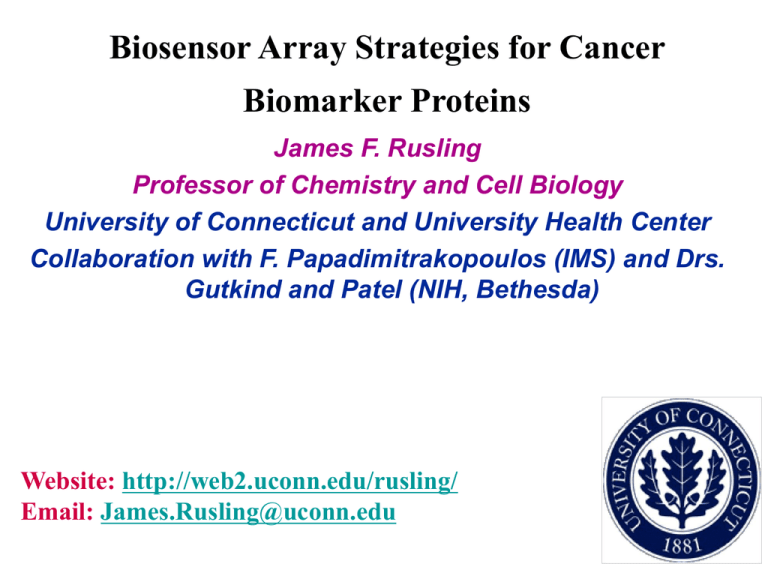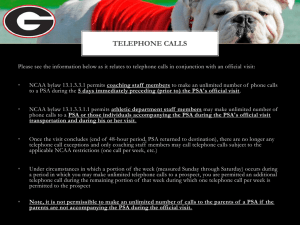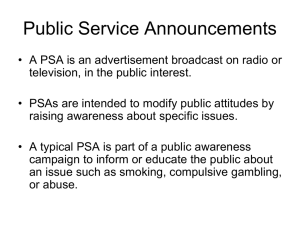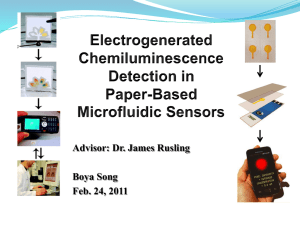
Biosensor Array Strategies for Cancer
Biomarker Proteins
James F. Rusling
Professor of Chemistry and Cell Biology
University of Connecticut and University Health Center
Collaboration with F. Papadimitrakopoulos (IMS) and Drs.
Gutkind and Patel (NIH, Bethesda)
Website: http://web2.uconn.edu/rusling/
Email: James.Rusling@uconn.edu
Cancer Biomarkers: National Institutes of Health –
molecules that can be objectively measured and
evaluated as indicators of normal or disease processes
and pharmacologic responses to therapeutic intervention
Cancer Biomarker Proteins: increase in serum concentration
At the onset of cancer, even before tumor develops
• Multiple proteins must be measured for reliable predictions
• Excellent hope for early detection and treatment monitoring
• May also be able to monitor inflammation
• May facilitate new therapies
Key aspects and needs:
• Ultrasensitive detection of multiple cancer biomarkers
• Long term objectives
1. early cancer detection and monitoring
2. tools for cancer research and surgical decisions
• point-of-care (POC) clinical assays – need to be
cheap, simple, fast, accurate, multiplexed
Expensive, and complex methodologies such as LCMS/MS, some automated optical-based methods are
currently not competitive for POC
Reviews:
Biomarker Targets: 1. Prostate Specific Antigen
PSA - Single chain
glycoprotein , MW 33 kDa
Sensitive, specific biomarker
for detection of prostate
cancer years before clinical
signs of disease
Detection of PSA in serum:
clinical detection of prostate
cancer: 4-10 ng/mL
Adapted From Brookhaven Protein Databank
Led to less invasive
treatment protocols, avoid
surgery
2. Interleukin 6 (IL-6)
- prostate and oral cancer biomarker
- human plasma conc. normal < 6 pg/mL; cancer 20-1000 pg/mL
ELISA- enzyme linked immuno-sorbent assay
96-well plate
Well in plate
Antigen =
Protein,
pathogen
Secondary antibody
enzyme label
and labels
Primary
antibody
Antibodies capture
The antigen
Detection by optical absorbance plate
reader after running enzyme reaction
that gives a colored product
• Reliable method for over 30 years
• Best DL ~ 3 pg/mL in serum
• many commercial assay kits for single proteins
• limitations in sample size, speed, multiplexing
Possible approaches:
• fluorescence labels
• surface plasmon resonance, SPR
• Electrochemiluminescence (ECL) –Ru(bpy)32+ labels
• bead based assays, ECL or Fluorescence
S
Slope = sensitivity
Detection limit = blank signal + 3x avg. noise
Conc. protein
Multilabel Strategies – high sensitivity
• detection by fluorescence, amperometry, ECL
• non-specific binding must be minimized in any immunoassay
Possible multilabel strategies
Dissolve, measure M+n
Also used on particles
Up to 400,000 labels
SPR arrays
– measure refractive index at interface
– potentially label free
-More susceptible to Non-specific binding (NSB)
Bead-based protein assays
Label – enzyme;
Fluorophor;
DNA, RuBPY(ECL)
+
Protein in
sample
multi-enzymeMagnetic bead-Ab2
Bead captures protein,
Magnetic separation, wash
Multiple labels
Detection:
• ECL – RuBPY label
• Fluorescence – Fl. Label
• 1-10 pg/mL DL
• $200,000 for machine
Magnet under well in 96-well plate, wash to remove NSB
2.
1.
A
conventional
Single electrode
AuNP film
B
Electrochemical
Immunosensors
Ab2-enzyme
AuNP
Capture Antibody
Multilabel magnetic
particle, on-line
capture
Multi-enzymeProtein analyte Magnetic particle-Ab2
AuNP-based immunosensors – single sensors nanostructures
sensor + massive multilabel strategies
AFM, carboxylated-AuNPs on polycation underlayer
Antibodies on AuNPs
Rotating disk amperometry (A)
and calibration for
PSA on AuNP platform
AuNPs:
DL for PSA = 0.5 pg/mL (8 x)
Accurate PSA detection in cell lysates and patient serum
Using AuNP-based immunosensors
Vigneshwara n Mani, Bhaskara V. Chikkaveera iah, Vyomesh Patel, J. Silvio Gutkind, and James F.
Rusling, Ultrase nsitive Immunosensor for Cancer Biomarker Proteins using Gold Nanoparticle Film
Electrodes and Multienzyme-Particle Amplifi cation. ACSNano , 2009, 3, 585Ğ594 .
SWNT array for 4 prostate cancer proteins in human serum vs. ELISA
8-sensor
array
Bhaskara V. Chikkaveeraiah, Ashwin Bhirde, Ruchika Malhotra, Vyomesh Patel,
J. Silvio Gutkind, and James F. Rusling, Single-Wall Carbon Nanotube Forest
Immunoarrays For electrochemical measurement of 4 Protein Biomarkers for
Prostate Cancer, Anal. Chem., 2009, 81, 9129–9134.
5 nm Au nanoparticle vs. single wall nanotube electrodes
• head to head comparison on IL-6 detection show better
Detection limits and better linearity with AuNPs
• AuNPs are easier to handle and produce highly reproducible
electrodes
Bernard S. Munge, Colleen E. Krause, Ruchika Malhotra, Vyomesh Patel, J. Silvio
Gutkind, and James F. Rusling, Electrochemical Immunosensors for Interleukin-6.
Comparison of Carbon Nanotube Forest and Gold Nanoparticle platforms,
Electrochem. Comm., 2009, 11, 1009–1012
Off-line capture magnetic particle microfluidic strategy
A
Conventional,
single label
array electrode
B
Electrical
contacts
Multilabel magnetic
Particle, off line
capture
-0.2V + H2O2 + HQ signal
8 electrodes
In channel
Ab2-enzyme
AuNP
Capture Antibody
Protein analyte
1 mm multi-enzymeMagnetic particle-Ab2
7000-400,000 labels
8-electrode PDMS microfluidic array
electrodes
Electrical contacts
Components of microfluidic device made of micro-machined
polymethylmethacrylate), soft PDMS microfluidic channel + screen printed 8 electrode
carbon array
Microfluidic protein assay system
Microfluidic array detection of PSA in serum samples
Using off-line capture with 1 mm multilabel magnetic particle;
Detection limit ~100 fg/mL PSA in 10 mL serum; 5-fold better
than manual assay without off-line capture
Microfluidic array data for mixture of PSA and IL6 in serum
Flow rate : 100 µL/min
H2O2 : 100 µM
Hydroquinone : 1 mM
Limit of detection of PSA: 225 fg/mL
Limit of detection of IL6 : 300 fg/mL
Low cross reactivity of PSA and IL-6
Ab1
PSA
IL6
PSA
2-5%
IL6
1-3%
Immunosensor assay validation on human serum
PSA
IL-6
Serum Protein Biomarkers for
Oral Cancer
Interleukin-6 [IL-6]
Interleukin-8 [IL-8]
Vascular Endothelial Growth Factor
[VEGF]
Vascular Endothelial Growth Factor C
[VEGF-C]
Trikha, M.; Corringham, R.; Klein, B.; Rossi, J. Clin. Cancer Res. 2003, 9, 4653-4665
Hebert, C. A.; Baker, J. B. Cancer Invest. 1993, 11, 743-750
O-charoenrat, O.; Rhys-Evans, P.; Eccles, S. A. Cancer 2001, 92, 556-568
Microfluidic Immunoarray: Oral Cancer Biomarkers
Off-line capture using magnetic particles with 400,000 HRPs
IL-6
DL: 10 fg mL-1
VEGF
DL: 8 fg mL-1
IL-8
DL: 15 fg mL-1
VEGF-C
DL: 60 fg mL-1
Protein Array using RuBPY ECL label
Immunoassays in 10 mL wells
Carbon (PG) chip
(no microelectronics)
SWCNT forest
ECL = Electrochemiluminescence
Detection labels are 100 nm d. silica with internal RuBPY
Forster and Voss,
1980s (synthesis)
camera
computer
RuPVP
Solid PG chip
array
Spots contain capture
antibody on RuPVP ECL
polymer
Potentiostat
1.25 V
ECL ARRAY with CCD camera for detection
ECL arrays for detection of PSA and IL-6
DL ~ 0.1 pg/mL
2 ng/mL
0.2 ng/mL
0.1 pg/mL
Control
0
Surface plasmon resonance (SPR) detection of protein
biomarkers using superparamagnetic beads labels
SPR response to PSA in Serum with Magnetic and Silica labels
Using off-line capture with 1 mm magnetic particle label;
Detection limit ~10 fg/mL PSA
Ultrasensitive multiple protein arrays:
• Combining nanostructured sensors or SPR
with (multi-label) magnetic particles gives
ultrahigh sensitivity in fg/mL range
• Microfluidics with off-line analyte protein
capture gives very low S/N, semiautomated
• May open door to new ultralow abundance
biomarkers
• ECL provides simpler array for protein
detection, no microelectronic chip needed
Cancer Biomaker Protein Measurements
• as yet, limited POC or clinical use except for PSA
• ELISA, commercial kits, one protein, 3 pg/mL DL
• bead based methods, up to 10 proteins, equip. and kits
expensive, 1-10 pg/mL DLs
• LC-MS, great for discovery, emerging for routine tests
• new experimental methods promise ultrasensitivity,
detection in fg/mL range, multiplexing
- microfluidic amperometric arrays, multilabel
- ECL arrays, simplicity
- SPR arrays with magnetic particle labels
- fiber optic microwell arrays – D. Walt (Tufts)
- DNA label “bar-codes” - C. Mirkin (Northwestern)









